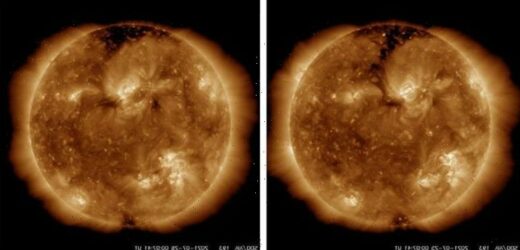NASA scientist explains what solar wind is
We use your sign-up to provide content in ways you’ve consented to and to improve our understanding of you. This may include adverts from us and 3rd parties based on our understanding. You can unsubscribe at any time. More info
Space weather forecasters expect the stream of charged particles and plasma to reach Earth by Wednesday, July 28. The solar winds are escaping from a “sinuous hole” spotted in the Sun’s northern hemisphere on July 25 and will lead to some “geomagnetic unrest” in the coming days. According to the US space agency NASA, solar winds typically reach speeds between one and two million miles per hour.
Solar winds come from areas of the Sun known as coronal holes – areas where the Sun’s outermost layer is colder, darker and denser.
The website SpaceWeather.com expects the stream of solar winds to hit the planet mid-week.
The website said on Monday, July 26: “Today, Earth’s magnetic field is quiet.
“It should stay that way until July 28 when a narrow stream of solar winds arrives.


“The gaseous material is flowing from a sinuous hole in the Sun’s atmosphere, and could trigger minor (Kp=4) geomagnetic unrest.”
The so-called K-index is used to characterise the intensity of geomagnetic storms and indicates whether forecasters should issue a warning.
According to the US Space Weather Prediction Center’s (SWPC) three-day forecast, a full-blown solar or geomagnetic storm is not expected to form.
Solar storms can have a wide range of impacts on the planet by disrupting power grids and satellite operations.
At their worst, solar storms can cause temporary or complete blackouts and affect GPS and radio communications.
Solar storm could cause ‘catastrophic damage’ to UK
The SWPC said: “No G1 (Minor) or greater geomagnetic storms are expected.
“No significant transient or recurrent solar wind features are forecast.”
Similarly, the SWPC does not expect any solar radiation storms or radio blackouts over the next day.
However, depending on your location, you might be able to see beautiful aurora effects.
Auroras are beautiful displays of light that typically appear in the northernmost and southernmost parts of the planets.


Also known as polar lights, auroras are caused by disturbances in the magnetosphere – the region of space dominated by Earth’s magnetic field – caused by solar winds.
The SWPC explained: “The Aurora Borealis (Northern Lights) and Aurora Australis (Southern Lights) are the result of electrons colliding with the upper reaches of Earth’s atmosphere.”
When electrons collide into atoms and molecules of oxygen and nitrogen, they transfer their energy onto them.
When the charged atoms return to their original state, they give off the excess energy in the form of light.
The SWPC added: “This is similar to how a neon light works.
“The aurora typically forms 80 to 500km above the Earth’s surface.”
Solar activity with a KP value of four is expected to produce aurora effects over parts of Europe, North America and Asia.
The website SpaceWeatherLive.com explains these may be seen as far south as Vancouver in Canada and Minneapolis in the US.
In Europe, these may be visible over Oslo, Stockholm, Helsinki and St Petersburg.
Source: Read Full Article

